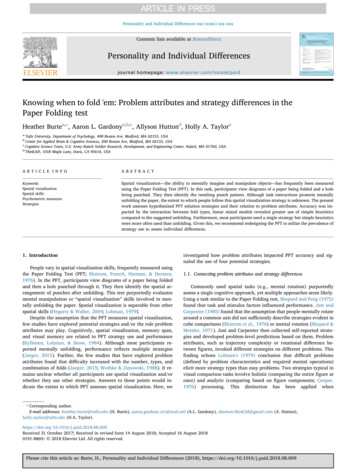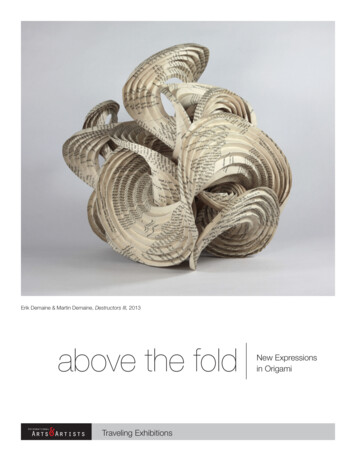
Transcription
Personality and Individual Differences xxx (xxxx) xxx–xxxContents lists available at ScienceDirectPersonality and Individual Differencesjournal homepage: www.elsevier.com/locate/paidKnowing when to fold 'em: Problem attributes and strategy differences in thePaper Folding test⁎Heather Burtea, , Aaron L. Gardonya,b,c, Allyson Huttond, Holly A. TayloraaTufts University, Department of Psychology, 490 Boston Ave, Medford, MA 02155, USACenter for Applied Brain & Cognitive Sciences, 200 Boston Ave, Medford, MA 02155, USAcCognitive Science Team, U.S. Army Natick Soldier Research, Development, and Engineering Center, Natick, MA 01760, USAdThink3d!, 1018 Maple Lane, Davis, CA 95616, USAbA R T I C LE I N FOA B S T R A C TKeywords:Spatial visualizationSpatial skillsPsychometric measuresStrategiesSpatial visualization—the ability to mentally imagine and manipulate objects—has frequently been measuredusing the Paper Folding Test (PFT). In this task, participants view diagrams of a paper being folded and a holebeing punched. They then identify the resulting punch pattern. Although task instructions promote mentallyunfolding the paper, the extent to which people follow this spatial visualization strategy is unknown. The presentwork assesses hypothesized PFT solution strategies and their relation to problem attributes. Accuracy was impacted by the interaction between fold types, linear mixed models revealed greater use of simple heuristicscompared to the suggested unfolding. Furthermore, most participants used a single strategy but simple heuristicswere more often used than unfolding. Given this, we recommend redesigning the PFT to utilize the prevalence ofstrategy use to assess individual differences.1. IntroductionPeople vary in spatial visualization skills, frequently measured usingthe Paper Folding Test (PFT; Ekstrom, French, Harman, & Dermen,1976). In the PFT, participants view diagrams of a paper being foldedand then a hole punched through it. They then identify the spatial arrangement of punches after unfolding. This test purportedly evaluatesmental manipulation or “spatial visualization” skills involved in mentally unfolding the paper. Spatial visualization is separable from otherspatial skills (Hegarty & Waller, 2004; Lohman, 1979).Despite the assumption that the PFT measures spatial visualization,few studies have explored potential strategies and/or the role problemattributes may play. Cognitively, spatial visualization, memory span,and visual memory are related to PFT strategy use and performance(Kyllonen, Lohman, & Snow, 1984). Although most participants reported mentally unfolding, performance reflects multiple strategies(Jaeger, 2015). Further, the few studies that have explored problemattributes found that difficulty increased with the number, types, andcombination of folds (Jaeger, 2015; Wothke & Zimowski, 1988). It remains unclear whether all participants use spatial visualization and/orwhether they use other strategies. Answers to these points would indicate the extent to which PFT assesses spatial visualization. Here, weinvestigated how problem attributes impacted PFT accuracy and signaled the use of four potential strategies.1.1. Connecting problem attributes and strategy differencesCommonly used spatial tasks (e.g., mental rotation) purportedlyassess a single cognitive approach, yet multiple approaches seem likely.Using a task similar to the Paper Folding test, Shepard and Feng (1972)found that task and stimulus factors influenced performance. Just andCarpenter (1985) found that the assumption that people mentally rotatearound a common axis did not sufficiently describe strategies evident incube comparisons (Ekstrom et al., 1976) or mental rotation (Shepard &Metzler, 1971). Just and Carpenter then collected self-reported strategies and developed problem-level predictions based on them. Problemattributes, such as trajectory complexity or rotational difference between figures, invoked different strategies on different problems. Thisfinding echoes Lohman's (1979) conclusion that difficult problems(defined by problem characteristics and required mental operations)elicit more strategy types than easy problems. Two strategies typical invisual comparison tasks involve holistic (comparing the entire figure atonce) and analytic (comparing based on figure components; Cooper,1976) processing. This distinction has been applied when⁎Corresponding author.E-mail addresses: heather.burte@tufts.edu (H. Burte), aaron.gardony.civ@mail.mil (A.L. Gardony), ahutton.think3d@gmail.com (A. Hutton),holly.taylor@tufts.edu (H.A. Received 31 October 2017; Received in revised form 14 August 2018; Accepted 16 August 20180191-8869/ 2018 Elsevier Ltd. All rights reserved.Please cite this article as: Burte, H., Personality and Individual Differences (2018), https://doi.org/10.1016/j.paid.2018.08.009
Personality and Individual Differences xxx (xxxx) xxx–xxxH. Burte et al.accuracy. With these in mind, strategies can then be identified based onthe response item selected relative to the probe attributes.We investigated three problem attributes: number of folds, type of fold,and occlusion (Table A.1). Although the PFT instructions ask participants toimagine unfolding the paper, some problems can be answered withoutunfolding all folds (Fig. 3). To distinguish between required and unrequiredfolds, the term number of folds indicates all folds and number of relevant foldsindicates only folds necessary to identify the correct answer.Although every fold occludes a part of the paper, most folds result inthe edges of the occluded part being still visible, or the edges of thefolds lie directly on top of one another (Fig. 4). In other instances, an“occlusion” occurs. Occlusions happen when a fold “hides” anotherfold, in a way that some of the occluded fold's edge is no longer visible.Fold occlusions occur when the location of the punch falls outside theoccluded area whereas punch occlusions occur when the punch locationfalls within the occluded area.We made a priori predictions about how each problem attributewould impact PFT accuracy based on the demands the attributes madeon cognitive processing. Given that each additional fold likely necessitates additional cognitive effort, we hypothesized that accuracyshould decrease with more folds. If while viewing the probe, peopleidentify which folds contribute to solving the problem, they may focusonly on relevant folds. If so, PFT accuracy should decrease with morerelevant folds as long as assessing a fold's relevance does not carryadditional cognitive effort.Whereas single folds may be easy to visualize, fold combinationsmay be more challenging. We hypothesized that problems involvingocclusion (particularly punch occlusion) require more cognitive effortdue to occluded details that must be held in memory. Given this, wepredicted that horizontal and vertical folds will be easiest because occlusions are rare and there are limited possible fold combinations.Corner folds (in combination with horizontal and vertical folds) aremoderately difficult by introducing more complex fold combinations.Finally, diagonal folds (in combination with other folds) present thebiggest challenge by introducing complex combinations that routinelyinclude occlusions. The interaction of diagonal folds with other foldtypes also produces “non-perceptual matches”. These are problemswhere the punch location in the probe (e.g., in the top-right corner)does not match the punch location in the correct answer (e.g., in thebottom-right corner). We hypothesized that not having a match between probe and response punch locations also requires more effort dueto memory demands.Fig. 1. An example PFT problem with its probe and response items.Fig. 2. Four PFT fold types.understanding individual differences in mental rotation performance(Khooshabeh, Hegarty, & Shipley, 2013; Li & O'Boyle, 2013).Overall success on spatial tasks may increase when flexibly employing different strategies, depending on individual problems. In fact,mental rotation strategies change for same versus different trials(Gardony, Taylor, & Brunyé, 2014), and shift as problem difficulty increases (Gardony, Eddy, Brunyé, & Taylor, 2017). These studies illustrate why investigating strategies is essential, and that problem attributes and strategies often interact.In this paper, we investigated how problem attributes both impactedPFT accuracy and signaled use of four potential strategies. Previous worksuggested that difficulty increases with number of folds, occlusions, asymmetrical folds, and fold combinations (Jaeger, 2015; Kyllonen et al., 1984).Beyond these studies, research has not systematically analyzed how PFTproblem attributes impact strategy use. Knowing the answer to this wouldhelp interpret individual differences in PFT accuracy and its relationship toother spatial measures. The present work used linear mixed models (LMM;Bates, Mächler, Bolker, & Walker, 2015) to predict accuracy and identifystrategies based on problem attributes individually and nested togetherunder each participant. Furthermore, a strategy categorization scheme wasdeveloped to provide insights into each participants' strategy use.1.2. Problem attributes and predictions1.3. Strategies and predictionsEach PFT problem includes the probe and the response items (Fig. 1).The probe contains images depicting a paper being folded and a holepunched through it. Probes include four fold types: horizontal, vertical,corner, and diagonal (Fig. 2). The punch locations play critical roles in theresponse items. The response items depict possible punch configurations after unfolding the paper. The correct item accurately depictspunch locations, whereas the distractor items depict incorrect locations.Based on the probes, we identified problem attributes that might impactWe identified four potential PFT strategies based the PFT instructions and insights from participants during debriefing sessions in previous studies. Using the relationship between probe items and thelikelihood of incorrectly selecting distractors items (Appendix A), wesought to determine whether PFT accuracy could reveal strategy use.The PFT instructs participants to use a folding-unfolding strategy,namely to imagine unfolding the paper to reveal the punchFig. 3. Two methods of counting folds with correct answers on the right. A and C shows all of the folds, then using the same probes, B and D shows relevant folds.2
Personality and Individual Differences xxx (xxxx) xxx–xxxH. Burte et al.OcclusionProbecorrect item follows the simple algorithm and on three of the 14 problems where the correct item follows the relevant algorithm, no distractors follow the algorithms. In these cases, following a fold-to-punchalgorithm guarantees a correct answer. Although these strategies do notalways lead to finding the correct answer, they can sometimes lead tothe correct answer and/or they can reduce the set of response items.To summarize, we investigated how PFT problem attributes(number of folds, type of folds, and occlusion) impact accuracy and howthese attributes reveal evidence for strategy use (folding/unfolding,perceptual match, and simple or relevant fold-to-punch).CorrectFoldPunchNone2. Methods2.1. ParticipantsFig. 4. Probes depicting fold occlusion, punch occlusion, and no occlusion. Thegrey dashed line (not in the PFT) represents the occluded edge. The light greyfill (also not in the PFT) represents the occluded area.Participants were recruited from Amazon's Mechanical Turk(MTurk), an online platform that crowd sources “workers” to completeonline tasks. Participants gave informed consent online before and weredebriefed online after the experiment in accordance with theDeclaration of Helsinki. MTurk workers with 95% completion rates,fluent in English, and in the US completed the experiment. In total, 220completed the experiment, but 17 were dropped due inability to pairdata, 18 were dropped for PFT performing below chance ( 20%),seven were dropped for completing the PFT in under 2 min, and 29were dropped for failing to properly answer a catch question. The remaining 149 (68%) participants (average age: 32 years; range: 19–64;SD: 8 years; 39% female) were included in the analysis.configuration (Fig. 5). By explicitly instructing this strategy, it makessense that the PFT is thought to assess spatial visualization. This strategy's high cognitive load might make it unattractive for complexproblems or for individuals with poor spatial skills. When using thisstrategy, more folds should negatively impact accuracy, but it mightdepend on whether participants consider all or only relevant folds.Accuracy should also reflect the number of folds implicitly depicted indistractor items (Table A.2). For instance, a common error when usingthis strategy might be to skip mentally unfolding a fold. A successfuldistractor might depict the punch configuration resulting from thiserror. For example, in a three-fold problem, distractors that implicitlydepict two folds might better “distract” from the correct item. In otherwords, when distractor items successfully “distract” then accuracyshould drop.The perceptual match strategy involves matching the punch location in the probe to the punch locations in the response items. If theprobe shows a center-top punch (Fig. 6), a participant might select aresponse item with a center-top punch (i.e., perceptual match) and/orrule out items without a center-top punch (i.e., non-perceptual match).Although more efficient than the folding-unfolding strategy, the perceptual match strategy is more error-prone. A limitation of this strategyis that not all correct answers have a perceptual match. For 16 of 20problems, the correct item has a perceptual match (Table A.3), so accuracy should be better on these problems. Accuracy will also dependhow many distractors have a perceptual match. When more distractorshave perceptual matches, accuracy should decrease.Fold-to-pu
Using a task similar to the Paper Folding test, Shepard and Feng (1972) . around a common axis did not sufficiently describe strategies evident in cube comparisons (Ekstrom et al., 1976) or mental rotation (Shepard & Metzler, 1971). Just and Carpenter then collected self-reported strate- gies and developed problem-level predictions based on them. Problem attributes, such as trajectory .











